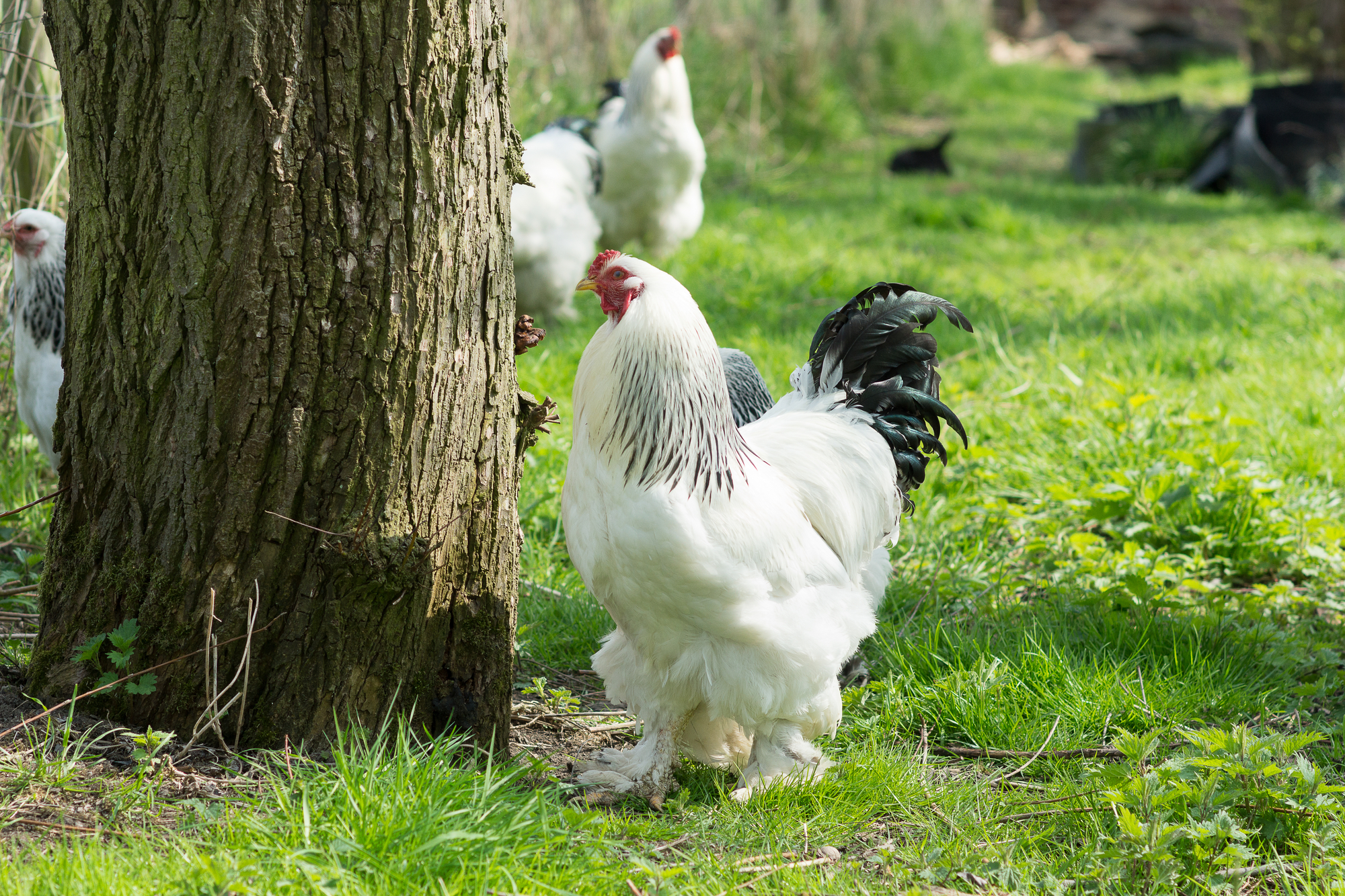Are you looking for a chicken breed that is large, docile, and easy to care for? If so, Brahma chickens may be the perfect breed for you!
In this comprehensive guide, we’ll cover everything you need to know about Brahma chickens, from their history and origins to their unique physical characteristics.
We’ll also share some tips on how to care for your Brahma chickens so that they can thrive in your flock.
So if you’re ready to learn more about these gentle giants, read on!”
- What Are Brahma Chickens And Where Do They Come From Originally?
- How Big Do Brahma Chickens Get?
- What Do Brahmas look like?
- Brahma Chicken Height/Weight
- What is the temperament of Brahma chickens like?
- How Long Do Brahma Chickens live?
- Are Brahmas Susceptible To Health Problems?
- Space Requirements For Brahmas
- Are Brahmas Good Egg Layers?
- Are Brahmas Broody?
- Are Brahmas Dual Purpose?
- How Much Feed Do Brahmas Need?
- How Heat And Cold Tolerant Are Brahmas?
- What Are Brahma Roosters Like?
- Are Brahma Chickens Expensive and Where Can They Be Bought?
- Are Brahma Chickens Good For Beginners?
- Are There Any Drawbacks?
- Brahma Cross Chickens
- Bantam Brahmas
- Our Experience With Brahmas
- What Others Say About Brahmas
- Closing Thoughts
What Are Brahma Chickens And Where Do They Come From Originally?
Brahma chickens (also known as the “King of All Poultry”) are a large breed of domestic fowl originating in the United States. They were developed in the 1840s through careful cross-breeding and were originally called Shanghai chickens.
An enduring legacy of their native habitat, the brahma genetics contain traits for cold weather and foraging that enable the birds to comfortably live on small farms, backyard poultry yards and other limited space environments.
Their breed characteristics, such as their hearty size and docile temperament, make them popular show birds; their efforts have been rewarded with recognition from several poultry organizations.
To this day, Brahma chickens remain a favorite bird among backyard farmers, both beginners and experienced individuals alike!
More on the history of the Brahma breed can be found here.
How Big Do Brahma Chickens Get?
Brahma chickens are large birds, ranging between 8-12 pounds when fully grown! Additionally, these gentle giants can reach over 30 inches tall and will impress everyone with their grandeur.
Best of all, this dependable breed is both easy to take care of and tolerant of cold climates making them an ideal choice for novice and experienced chicken keepers alike.
What Do Brahmas look like?
Brahma chickens are a majestic sight to behold! An old-time favorite, this chicken variety is known for its large size and feathered feet – its impressive silhouette often stands out amongst the other breeds.
They come in three varieties according to feather color – light, dark, and buff.
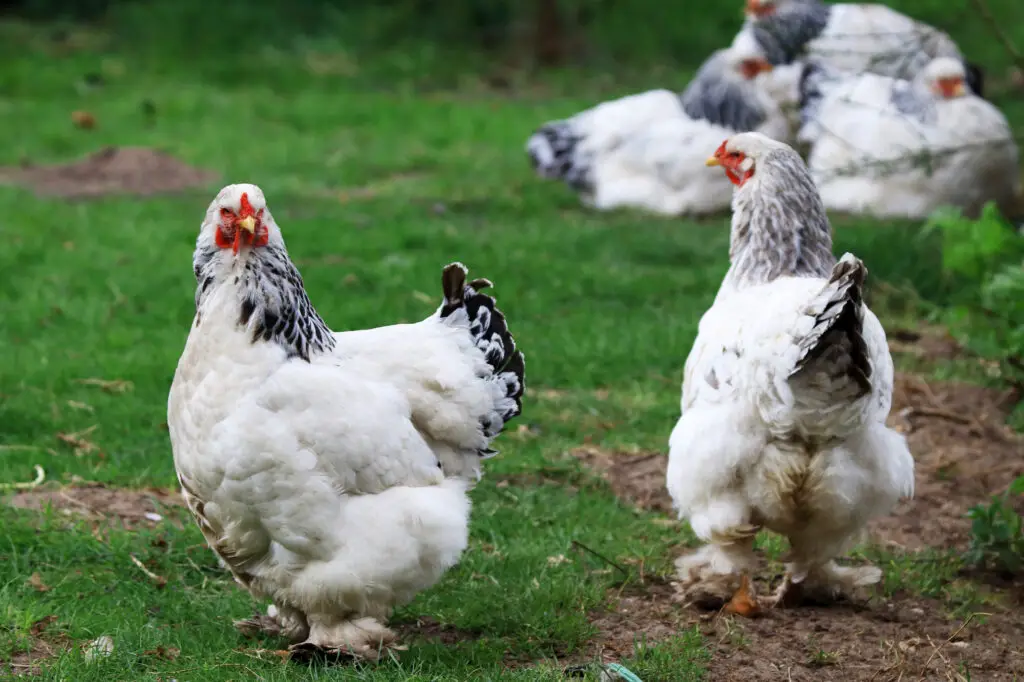

Light Brahma Chickens
The light Brahma’s feathers have white points on their wings and tail.
White Brahma chickens are truly gorgeous! With large, distinct white feathers, they’re sure to stand out in your flock.
They have pea combs give which give them an even more appeal.
Not to mention their bright orange earlobes and dark slate blue shanks that add the perfect amount of extra flair.
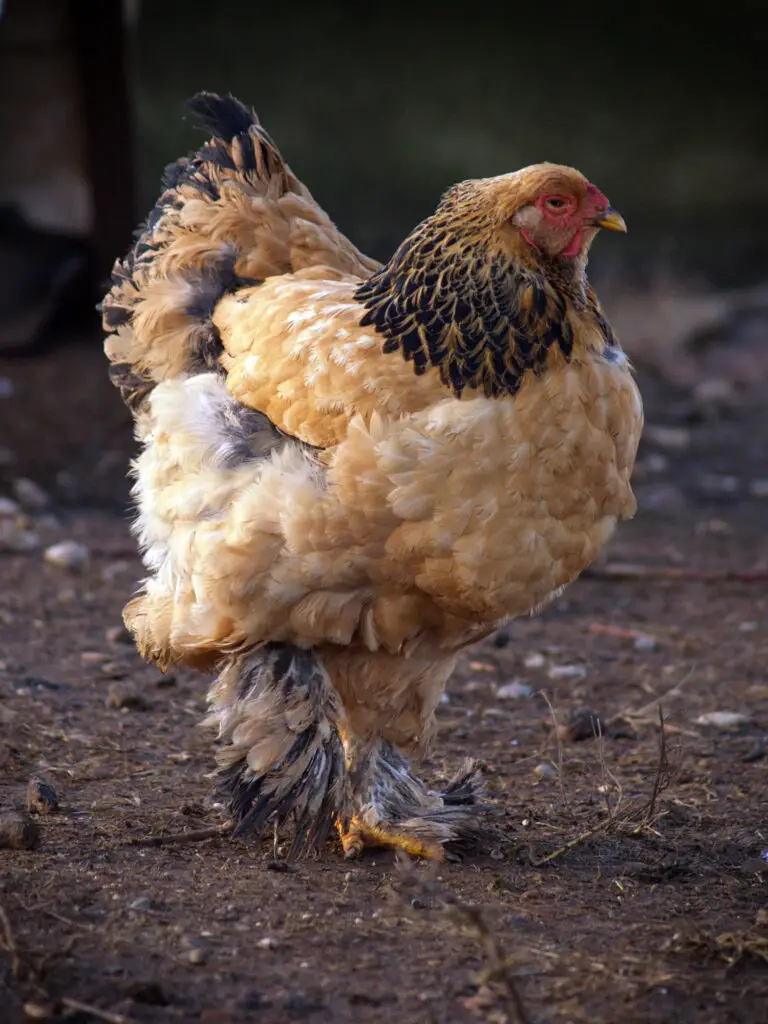
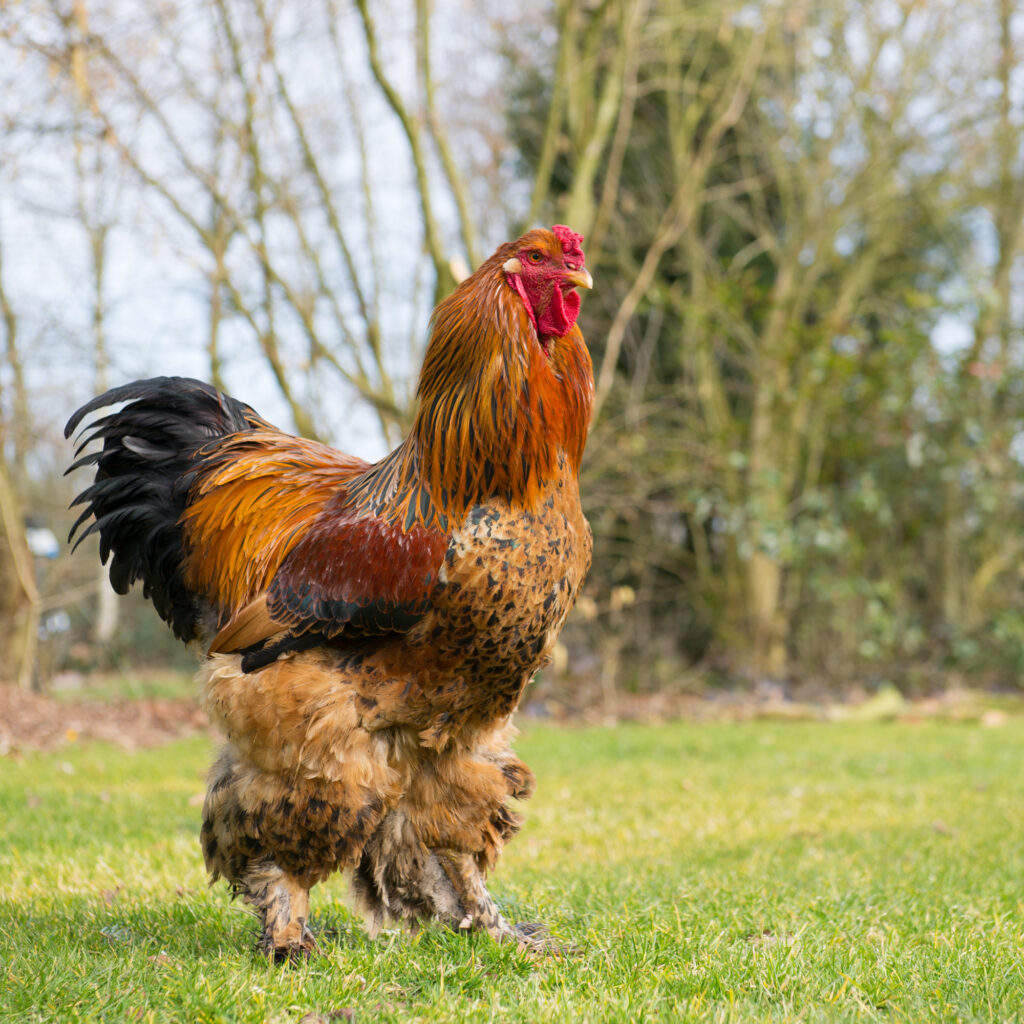
Buff Brahmas
Buff Brahmas are known for their beautiful feathers. They have deep golden brown feathers with a dark gold edging and secondary feathers that can appear almost black.
The top of the head is deep red along with a pea-shaped comb and wattles, both being reddish in color. Their shanks are usually white or yellow, depending on the phenotype.

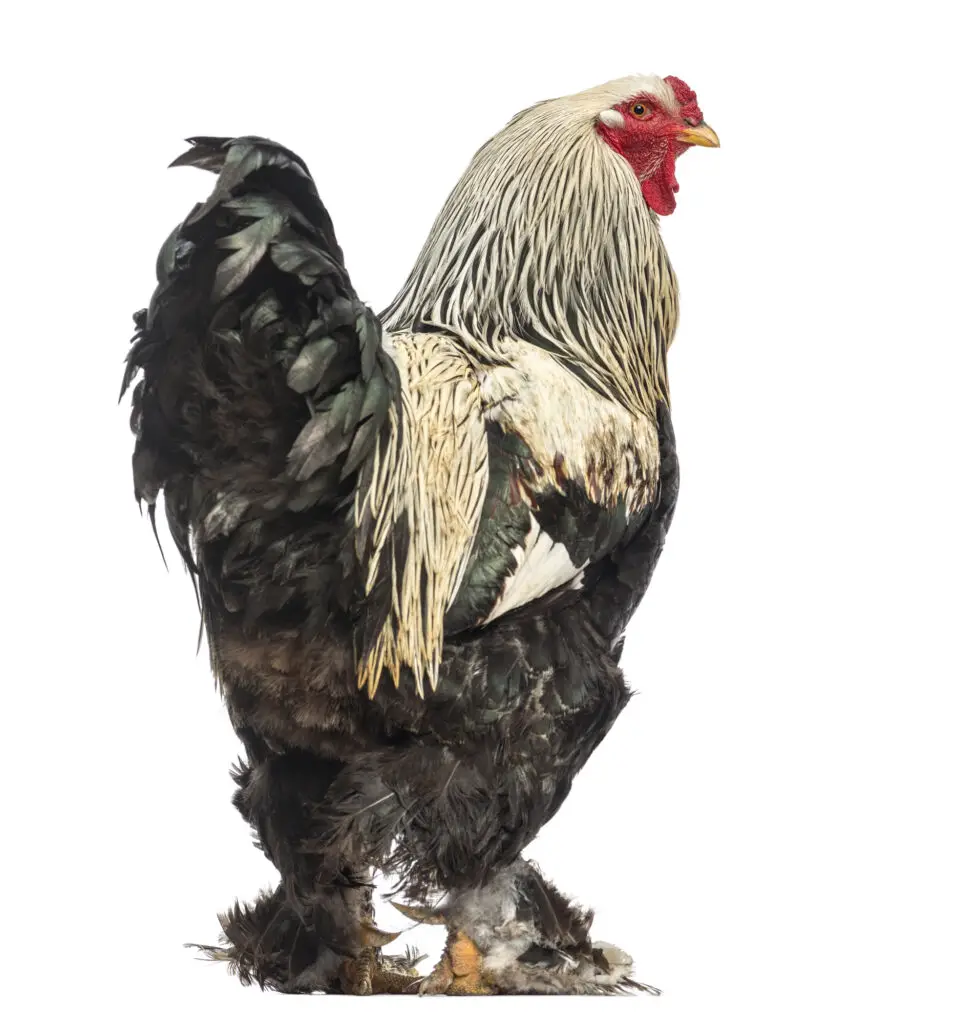
Dark Brahmas
Dark Brahmas sport feathers that range from deep black to slate grey. Its wings and tails possess beautiful shades of blue, green, and black that add another dimension to their already unique look.
Dark Brahmas have a few key physical characteristics that make them distinctive and easily recognizable.
They sport gorgeous feathers in shades of black and white, with hints of blue on the tips. Their sizable combs resemble that of a rooster’s, typically appearing red in color with five short points just below their beaks.
The shanks are usually light slate in coloration.
Brahma Chicken Height/Weight
- Cock (Rooster): Up to 13 lbs. ; Up to 30 inches tall!
- Hen: Up to 10 lbs.
- Cockerel (rooster under 1 year old): 10 lbs.
- Pullet (Hen under a year old): 8 lbs.
What is the temperament of Brahma chickens like?
Brahma chickens are known for their calm and gentle temperament, making them an ideal chicken to have around if you’re wanting peace and quiet.
Their great personalities make them easy to handle and they can be very friendly with people, although they might take a bit of time to warm up to you. Having said that, we have heard from Brahma owners who compared theirs to a friendly dog!
They usually don’t cause too much noise either so they make a great choice if you’re living in town or near neighbors.
When it comes down to it, Brahmas are low-maintenance birds that can be rewarding pets as well as good egg layers.
Keep in mind that there are always exceptions! Some Brahmas will likely be loud as well. Like people, they aren’t all the same. When laying eggs, they will definitely make the egg laying cackle and squawk that all hens do.
How Long Do Brahma Chickens live?
Similar to other chicken breeds, they live an average of 8-10 years.
Are Brahmas Susceptible To Health Problems?
Like other chickens, they are susceptible to mites, lice, and other parasites.
Due to their feathered feet, they can develop mud or snow build up around their toes which can be problematic for them and lead to foot problems if not taken care of.
This is something to consider if you live in a wet or snowy climate. We live in the rainy Pacific NW and did not have any issues with this type of clumping with our Brahmas, but we made sure to fill in any muddy areas with bedding.
In snowy climates, if the clumps of snow gather around their toes for too long, frostbite can occur.
In either scenario, get rid of these clumps by soaking them in water and rub them off with your hands.
Space Requirements For Brahmas
Because of their size, you’ll want to plan on a little more space per chicken for Brahmas. A minimum of 8 – 10 sf per chicken should work, but more is better if they are completely confined.
If your Brahmas have access to a run, allow for around 12 sf of space per chicken. Again, more is better if you can allow for it. Free ranging your Brahmas is the best, if your situation allows for it.
Are Brahmas Good Egg Layers?
Number Of Egg/Year: 150-200
Egg Size/Color: Medium – Large Brown Eggs.
Although not on the top of the list in egg production, Brahmas produce roughly 150 – 200 eggs/year. Not bad!
If you are looking strictly for egg laying breeds, Brahmas aren’t a bad choice to add to the flock.
Though not as prolific as the Novagen or other breeds known to excellent layers, Brahmas are near the middle of the egg laying breeds in overall egg production.
Are Brahmas Broody?
They can be. Of course not all brahma hens will be broody, but it’s something to keep in mind if you are considering this breed. For those of you wanting to hatch your own chicks, a Brahma hen could be the perfect breed to have around to set on those eggs!
When we had a light brahma, she was always in the nest! Although we weren’t hatching our chicks at that time, we didn’t mind seeing her in there every day.
Are Brahmas Dual Purpose?
Yes, not only do they lay beautiful brown eggs, they also provide tasty table fare. Brahmas are known for their quality meat. And because of their size, they will provide a lot of meat per bird!
How Much Feed Do Brahmas Need?
For egg laying chickens, simply feed them what you are feeding your other hens. Usually, it’s a 16% protein feed.
Because of their size, they will eat more than the other smaller members of the flock. Not a deal breaker in our opinion. We love the variety that Brahmas brought to our flock and the extra costs are worth it.
How Heat And Cold Tolerant Are Brahmas?
They do not tolerate heat as well so if you live in a hot climate, make sure they have plenty of shade, a properly ventilated coop, and unlimited access to water. For tips on keeping your chickens cool, read this article.
They are known to be very hardy in cold climates. As mentioned earlier, if you live in a snowy locale, make sure to check their feet for a build up of snow clumps if they are free ranging.
What Are Brahma Roosters Like?
As with other breeds, the best answer is, “it depends.” We know, not real definitive, but true. Most of the research we found shows that their overall demeanor is calm and docile, no different than their female counterparts.
However, there are always exceptions to the rule, especially with roosters! If you do get a rooster, the vast majority of them will likely be friendly. But if you get an aggressive one, it’s best to cull it to minimize losses in your flock.
Are Brahma Chickens Expensive and Where Can They Be Bought?
Historically speaking, Brahmas were very expensive (back in the 1840’s). But generally speaking you won’t pay more for Brahmas than any other breed of chicken. We have found them reasonably priced online and, occasionally, at our local farm store.
Where To Buy Brahmas?
Local Farms/Farm Stores: Finding them locally can sometimes be a challenge. You may be at the mercy of your local farm store who may or may not carry them on a regular basis.
Call around to see if they carry them, or look online for local poultry farms.
Online: Lots of options here!
Other Ideas:
- Craigslist – Can be hit or miss, but worth taking a quick look. Local chicken keepers may be selling some. Sometimes local hatcheries will place an ad in Craigslist.
- Facebook Groups – At the time of this article, there is a specific group “Brahma Chickens,” which has a huge following! There are options to buy Brahma chickens, and they will be easier to find in your local area.
Are Brahma Chickens Good For Beginners?
Yes! As stated earlier, Brahmas are calm and friendly which is a perfect fit if you’re new to raising chickens.
Are There Any Drawbacks?
Although we’ve hopefully established how wonderful this breed is, we need to be fair and look for any potential cons as well.
- Slower to mature: Unlike other breeds who can start laying at around 4-6 months, Brahmas aren’t usually laying until 7 months. And if you’re raising them for meat, the same time frame applies which can mean more feed costs.
- Feed Costs: They have to eat more to feed their large frames!
Brahma Cross Chickens
Some Brahma chicken keepers like to cross their brahmas with other breeds for added variety. This can include crosses with meat breeds, or other more prolific egg laying breeds.
For example, a Brahma / Novagen cross could create a larger chicken with greater egg laying capabilities. For more on crosses, see this forum.
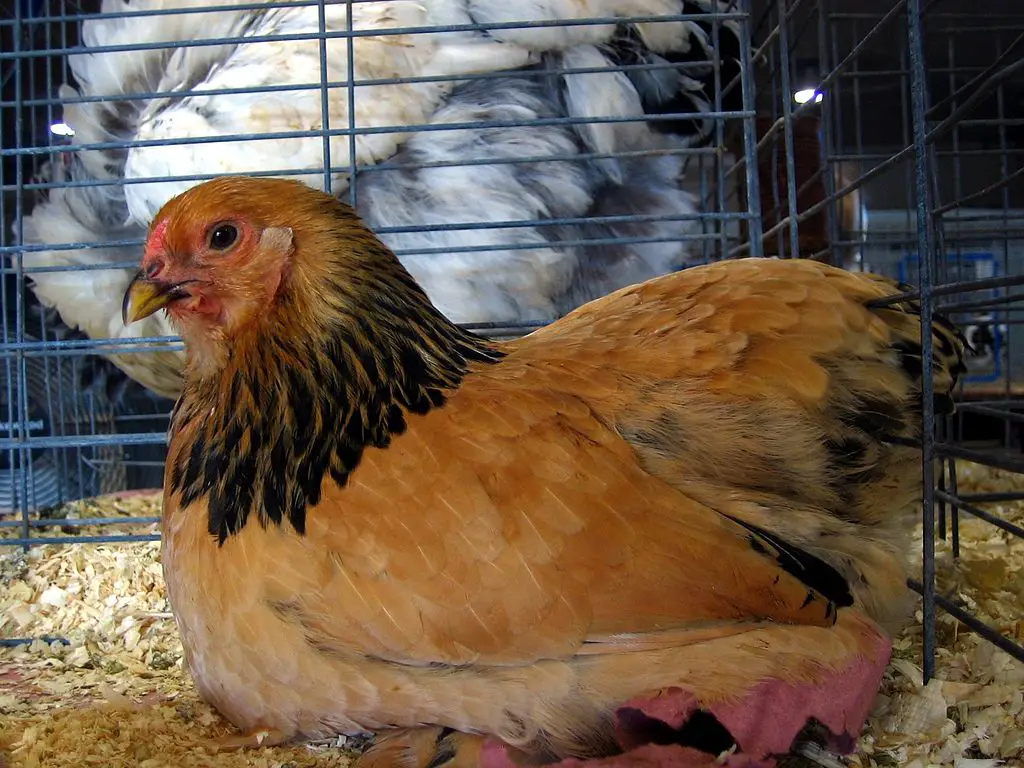
Bantam Brahmas
Bantam Brahmas are the smaller version of the Brahma breed. They are also a Heritage Breed, and have the same characteristics as their larger cousins.
They lay around 150 – 200 eggs/year and have the same friendly disposition. What’s great is that they consume far less feed!
Our Experience With Brahmas
We have owned both Buff and Light Brahmas over the years and have loved having them in the flock.
Yes, they ate a bit more than some of our smaller breeds, but we loved their docile personalities and simply watching those massive birds in the yard each day.
We highly recommend them for anyone who is thinking of getting into chickens!
What Others Say About Brahmas
Closing Thoughts
We hope you’ve gathered enough information here to make an informed choice on whether or not the Brahma chicken breed is right for you.
We are biased but think they are a great breed to have in the overall mix of your flock. If they were aggressive, we would not recommend them. But they’re quite sweet overall and if you can get over the fact that they’ll eat a bit more than the others, they will be a wonderful addition to your brood!
If you have experience with the Brahma breed, we’d love to hear about it! Feel free to comment below. Happy Chickening.

